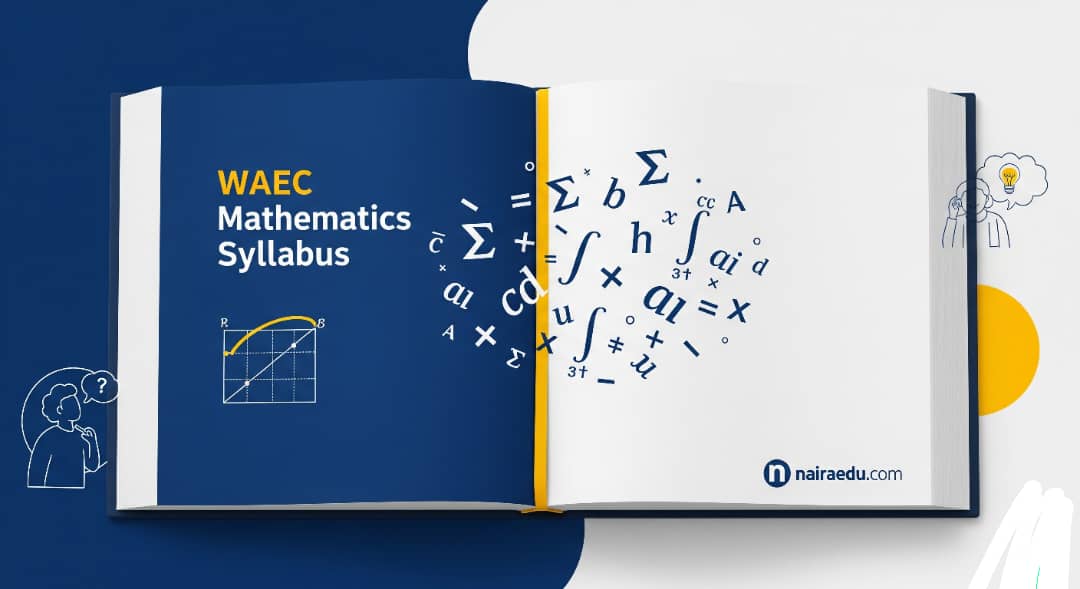The WAEC Syllabus for Mathematics 2026 is the essential roadmap for all students preparing for the upcoming West African Senior School Certificate Examination (WASSCE).
At Nairaedu.com, we understand that Mathematics is a core subject that demands a structured and strategic approach.
This compiled guide provides a comprehensive breakdown of the entire syllabus, outlining all the topics, objectives, and skills you need to master to achieve an excellent grade.
Mathematics is not just about memorizing formulas; it’s about developing logical reasoning and problem solving skills.
By following this guide, you will be able to identify key topics, allocate your study time efficiently, and build the confidence required to tackle any problem that appears in the exam. This is your first step toward success and a top-tier grade.
Aims and Objectives of the WAEC Mathematics Syllabus
The WAEC Mathematics syllabus is designed with specific objectives that go beyond preparing you for the exam. It aims to equip you with fundamental skills that are crucial for future academic and professional endeavors. The key aims are to:
- Assess Mathematical Competence: Evaluate your ability to perform accurate calculations, apply mathematical principles to solve practical problems, and demonstrate a solid grasp of concepts in Algebra, Geometry, and Statistics.
- Develop Problem-Solving Skills: Encourage you to analyze complex problems, think logically, and find effective solutions. This skill is vital in all fields, including science, engineering, business, and everyday life.
- Foster Logical and Precise Thinking: Promote clarity and precision in your thought processes. By following the syllabus, you will learn to structure your approach to problems, communicate your reasoning clearly, and make accurate deductions.
By mastering the objectives outlined in this syllabus, you are not only preparing for the WASSCE but also building a strong foundation for lifelong learning and critical thinking.
Understanding the WAEC Mathematics Examination Scheme
The WAEC Mathematics examination is a two paper test that evaluates both your foundational knowledge and your ability to apply mathematical concepts to more complex problems. A thorough understanding of this scheme is key to your preparation.
1. Paper 1: Objective
Format: This paper consists of 50 multiple-choice questions.
Duration: 1 hour 30 minutes
Weighting: This paper accounts for 40% of the total marks.
Content: Questions cover the entire syllabus, testing your quick recall and problem-solving skills across topics like Number and Numeration, Algebra, Geometry, and Trigonometry.
2. Paper 2: Essay
Format: This paper consists of structured and essay-type questions. It requires you to show your working clearly and provide detailed solutions.
Duration: 2 hours 30 minutes
Weighting: This paper contributes 60% of the total marks.
Content Breakdown:
- Section A: You must answer 10 compulsory questions. These are usually straightforward problems that test your fundamental understanding.
- Section B: You must choose and answer 3 questions out of 5 optional questions. These questions are more complex, requiring higher-level reasoning and a deeper application of mathematical principles.
The total time for both papers is 4 hours, so effective time management is critical to ensure you attempt all questions.
Detailed Breakdown of the WAEC Mathematics 2026 Syllabus
The WAEC Mathematics syllabus is organized into key sections to ensure a comprehensive understanding of the subject. Below is a structured breakdown of all the essential topics you need to study.
1. Number and Numeration
This section is the foundation of all mathematical concepts. Focus on mastering:
- Number Bases: Conversion between different bases (e.g., binary, decimal, octal) and performing basic arithmetic operations within them.
- Fractions, Decimals, and Percentages: Operations, conversions, and their application in real-life problems like profit, loss, and simple interest.
- Indices and Logarithms: Laws of indices and logarithms, and the use of logarithm tables and calculators to solve equations.
- Surds: Simplification, rationalization, and operations with surds.
- Modular Arithmetic: Understanding remainders and modulo operations.
2. Algebraic Processes
Algebra is essential for solving equations and understanding relationships between variables. Key topics include:
- Linear and Quadratic Equations: Solving equations in one or two variables. For quadratics, master factorization, completing the square, and the quadratic formula.
- Simultaneous Equations: Solving systems of two linear equations and linear-quadratic systems.
- Inequalities: Solving and graphing both simple and compound inequalities.
- Graphs: Plotting and interpreting linear and quadratic graphs. Understanding the use of graphs to solve equations.
- Polynomials and Algebraic Fractions: Simplification and operations involving polynomials and fractions.
3. Geometry and Mensuration
This section emphasizes spatial reasoning and measurement. You must understand:
- Angles and Polygons: Properties of different types of angles, calculating angle sums in polygons, and understanding similar and congruent figures.
- Circles: Properties of circles, including theorems on arcs, chords, and tangents.
- Perimeter and Area: Calculation of perimeters and areas of various 2D shapes like triangles, quadrilaterals, and circles.
- Volumes and Surface Areas: Calculation for 3D shapes like cubes, cylinders, cones, pyramids, and spheres.[Image of 3D geometric shapes]
4. Trigonometry
Trigonometry deals with the relationships between angles and sides of triangles. Key topics include:
- Trigonometric Ratios: Sine, Cosine, and Tangent (SOH CAH TOA).
- Angles of Elevation and Depression: Solving real-world problems involving heights and distances.
- Bearings: Using bearings to calculate directions and solve navigation problems.
- Trigonometric Identities: Understanding and applying basic trigonometric identities to simplify equations.
5. Statistics and Probability
This section introduces data analysis and the principles of chance. You will need to master:
Statistics:
- Data Presentation: Organizing data into frequency tables and using visualization tools like bar charts, pie charts, histograms, and frequency polygons.
- Measures of Central Tendency: Calculating the mean, median, and mode for both grouped and ungrouped data.
- Measures of Dispersion: Understanding range, variance, and standard deviation.
- Cumulative Frequency Curves (Ogive): Plotting and interpreting ogives to find median, quartiles, and percentile ranks.
Probability:
- Understanding both experimental and theoretical probability.
- Calculating probabilities of mutually exclusive and independent events using addition and multiplication rules.
6. Calculus and Vectors
These advanced topics test your understanding of change and vector operations. Be sure to study:
- Differentiation: Basic rules of differentiation, including the derivatives of algebraic functions. Understand its application in finding the slope of a curve and solving rate of change problems.
- Integration: The basics of definite and indefinite integrals and their application in finding the area under a curve.
- Vector Operations: Understanding vector representation, addition, subtraction, and scalar multiplication.
- Transformations: Applying geometric transformations such as translations, reflections, rotations, and enlargements.
ALSO READ: WAEC Syllabus for English Language 2026
Essential Tools and Materials for the Examination
To avoid any inconvenience and ensure a smooth exam experience, you must come prepared. WAEC has specific guidelines regarding the materials you can bring to the exam hall.
- Mathematical Set: A clean mathematical set is non-negotiable. It should contain a compass, protractor, ruler, and set squares.
- Non-Programmable Scientific Calculator: Only this type of calculator is allowed. Familiarize yourself with its functions before the exam to save time.
- Writing Materials: Bring pencils for diagrams and rough work, and a biro for your final answers.
- WAEC Registration Slip: This is your proof of identification. Do not forget it.
Note: Programmable calculators, mobile phones, smartwatches, and other electronic devices are strictly prohibited. Using them can lead to a cancellation of your results.
Proven Strategies to Pass WAEC Mathematics
Passing WAEC Mathematics with a high grade is achievable with the right strategy. Here are actionable tips to help you prepare effectively:
- Create a Structured Study Plan: Break down the syllabus into manageable daily or weekly goals. Allocate more time to challenging topics like Trigonometry and Calculus, and ensure you include regular revision sessions.
- Practice with Past Questions: Solving past WAEC questions is the most effective way to prepare. It familiarizes you with the exam pattern, question types, and time management. Focus on both objective (Paper 1) and essay questions (Paper 2) and try to understand the logic behind each solution.
- Focus on Weak Areas: Identify topics where you struggle and dedicate extra time to mastering them. Use textbooks, online tutorials, or seek help from a tutor or your teachers. Consistent practice is the key to building confidence in these areas.
- Show Your Work Clearly: In the essay paper (Paper 2), your process is as important as your final answer. The examiner awards marks for each step of your solution. Always show your work logically and neatly.
- Simulate Exam Conditions: Practice solving full papers under timed conditions. This will help you improve your speed, accuracy, and endurance, preparing you for the pressure of the actual exam.
Your success is within reach with consistent effort and the right approach. Trust the process, follow the syllabus, and you will achieve your academic goals.
YOU MAY LIKE: WAEC Syllabus for Physics 2026
Download the Official WAEC Mathematics Syllabus PDF
For your convenience, we have provided a downloadable PDF of the WAEC syllabus for mathematics. This document contains all the topics, examination schemes, and objectives in one place, ensuring you have everything you need for your preparation. Click the link below to get your copy.
waec-mathematics-syllabusDOWNLOAD PDF
A good grade in WAEC Mathematics is achievable with consistent effort, effective study techniques, and the right resources. At Nairaedu.com, we are here to guide you every step of the way. If you have any questions or need additional support, feel free to leave a comment below. Good luck with your studies!

Mr. Femi is an education blogger who simplifies exam updates and study tips for Nigerian students. His goal is to make learning smart, easy, and rewarding.

